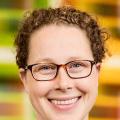Study: Web of sensors shows how pollution varies over space and time
EDF-funded research finds air pollution can change sharply over relatively short distances within an hour
An article published this week in the journal Environmental Science and Technology demonstrates how stationary sensor networks can reveal complex changes in air pollution within urban neighborhoods. Researchers from Lawrence Berkeley National Lab and the University of California, Berkeley, used a web of 100 black carbon monitors to show how pollution from traffic and industrial activity builds in West Oakland, CA. In analyzing data from the sensor network for 100 days, the team showed how traffic stops, industrial activity or even the shift times of truck drivers can impact air pollution.
“We’re now able to see both where and when pollution is at its worst—right down to the neighborhood block,” said Millie Chu Baird, Associate Vice President in EDF’s Office of the Chief Scientist. “This new study builds on our growing body of research into hyper-local pollution patterns, which is helping us identify potential sources and ultimately solutions.”
This study, which relied on the largest and densest ever network of inter-connected black carbon sensors found that pollution varied sharply over short timespans and distances of 100 meters or less and was strongly influenced by nearby land use, traffic patterns and pollution sources. Animations of several of the sensor readings can be viewed online. The team also built a tool, which allows users to select location, date and time, so they can watch as black carbon concentrations increase and decrease over time.
EDF convened the group of researchers and local advocates from the West Oakland Environmental Indicators Project (WOEIP), who recruited local residents and businesses to host 100 custom-built black carbon sensors at distinct locations across the 15 kilometer2 neighborhood for 100 days. The sensors, some of which were co-located with the Bay Area Air Quality Management District’s regulatory-grade monitors, sent hourly readings back to an online database built for the study. The final dataset includes up to nearly a quarter million hourly black carbon measurements.
Among the findings:
· Pollution patterns reflect daily commercial activity. Measurements from sensors on truck routes near the Port of Oakland averaged 200 percent higher than those on sensors placed upwind, with concentrations typically peaking as Port terminal gates opened around 8:00 a.m. Traffic patterns can cause spikes in black carbon – a sensor at a busy 4-way stop near a major Port entrance measured concentrations that averaged 60 percent higher than a sensor located less than 500 meters away on the same designated truck route
· It is possible to see the impact of night-time industrial activity on air pollution in neighborhoods, for example, at a park near a trucking facility that relied on auxiliary diesel engines to power refrigeration units at night, a sensor measured overnight black carbon concentrations more than twice the neighborhood average.
“We generated a technology that didn’t exist to make this invisible problem visible,” said Thomas Kirchstetter, Adjunct Professor at the University of California, Berkeley and the Director of the Energy Analysis and Environmental Impacts Division at Lawrence Berkeley National Lab, an author of the study. “We had to create a sensor that was as accurate as high-grade expensive instrumentation, but low enough in cost that we could distribute 100 of them throughout the community.”
For community groups, having this level of detail can aid in developing targeted strategies for cleaner air. For example, WOEIP is using this and data from earlier studies from EDF and partners to inform their advocacy under California’s Community Air Protection Program. “We’ve been waiting more than 20 years for this type of refined information,” Ms. Margaret Gordon, the organization’s Co-Director, said. This new study builds on EDF’s growing body of peer-reviewed research into air pollution’s patterns and impacts.
EDF has been studying air quality in Oakland, CA since 2015, when it partnered with Google to use Street View Cars to map air pollution. Since its initial 2017 study, EDF has also partnered with Kaiser Permanente to examine health impacts of local air pollution, which showed that elderly residents living in the most polluted areas of West Oakland would have more than a 40 percent greater risk of heart attack, surgery or death due to heart disease than elderly people living in less polluted areas of the neighborhood, similar to the elevation in risk related to a history of smoking. EDF plans to release similar mobile and stationary air pollution studies in Houston and London in the coming months. It has also begun measuring air quality with Google and the University of Utah in Salt Lake City.
“EDF is pioneering a new kind of policy-focused scientific research. Our hope is that this kind of peer-reviewed, actionable science will provide new opportunities for residents, activists and governments to approach pernicious problems like air pollution.” Baird said. “By providing a clearer, more detailed picture of the severity of pollution and its impacts, we can work together to develop solutions that have a profound impact on human health.”
With more than 3 million members, Environmental Defense Fund creates transformational solutions to the most serious environmental problems. To do so, EDF links science, economics, law, and innovative private-sector partnerships to turn solutions into action. edf.org
Latest press releases
-
Trump Administration Announces Unlawful Offshore Wind Halt
December 22, 2025 -
Governor Hochul Repeals "100-Foot Rule," Accelerating New York's Clean Energy Future
December 19, 2025 -
Colorado Air Regulators Approve Landfill Methane Standards
December 18, 2025 -
Proposal Would Guarantee Public Access to Air Quality Data
December 18, 2025 -
New Bill Will Help Keep Domestic Manufacturers Competitive
December 17, 2025 -
Satellite Data Shows Colorado Oil & Gas Methane Emissions Dropped as State Rules Took Effect
December 17, 2025











